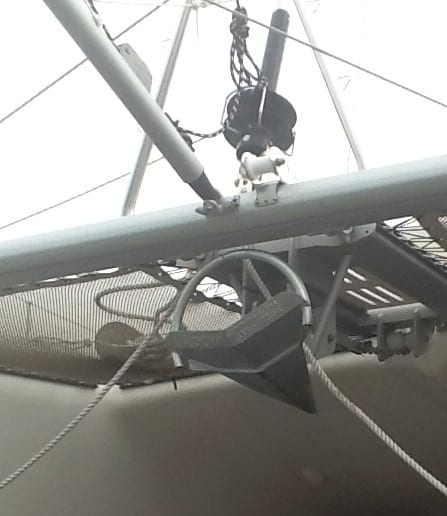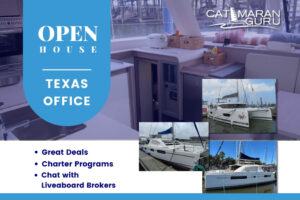
Catamaran owners have lots of choices of
different types of anchors as we have discussed before. But Stephen and I frequently recommend the
Rocna anchor.
We have used this anchor for the last 2 years on our own catamaran in different weather, current conditions, and seabeds. Its holding power is incredible. We cannot say enough good things about this anchor. It is pricey for an anchor, but worth every cent. As they say, a good anchor is cheap insurance.
Rocna Anchor History
The Rocna anchor was developed by Peter Smith (New Zealand), was commercially available in 2004 and has fast become very popular among cruisers. The Rocna uses a roll-bar like the Bügel anchor and both the high tensile steel shank and concave flukes are optimized to maximize efficiency, strength and durability. The Rocna will set reliably in almost any surface. The weight is concentrated on the digging part of the fluke and the a sharp chisel-like point helps fast setting of the anchor.
For more on the development of new generation anchors, and particularly the Rocna, read Peter Smith’s article on
New Generation Anchors. Though he, of course, is biased as he is the creator of the Rocna, the article is free from overt advertising and chock full of good information.
Another great read to better understand why Rocna has such a strong reputation in the boat anchor industry is
Technology of the Rocna Anchor. Reliability of our anchors is something most boat owners take for granted, but should we? After reading this article and better understanding the detailed quality process, I no longer take it for granted and have a greater appreciation for how Rocna rose to be many sailors’ favorite. It’s no wonder Rocna’s tagline is “Rock Solid”…they are!
Why Use a Rocna Anchor?
If you’ve detoured to read the articles mentioned above, you probably are already convinced as we are that a Rocna is a must for cruisers. Here are top reasons to purchase and train yourself on the use of a Rocna:
- Engineered to be fast-setting and to stay put
- High strength construction (be sure to read the “Technology of the Rocna Anchor” article mentioned above
- Wind and sea changes are no match for the Rocna which will reset on the rare occasion that it is jerked out of its position
- Effective in a variety of seabed types
- Excellent ability to penetrate even the most challenging seabeds such as kelp or grasses
If you are not yet convinced, give the video at right a look. It demonstrates a variety of anchors and their shortcomings which are overcome by the Rocna. Again, this is information presented by its creator, Peter Smith, but it is a factual documentary of Rocna performance and how it works.
Rocna Anchor Resources
What are your experiences with Rocna anchors? Have a harrowing tale of the Rocna being your savior? Comment below!
 Catamaran owners have lots of choices of different types of anchors as we have discussed before. But Stephen and I frequently recommend the Rocna anchor.
We have used this anchor for the last 2 years on our own catamaran in different weather, current conditions, and seabeds. Its holding power is incredible. We cannot say enough good things about this anchor. It is pricey for an anchor, but worth every cent. As they say, a good anchor is cheap insurance.
Catamaran owners have lots of choices of different types of anchors as we have discussed before. But Stephen and I frequently recommend the Rocna anchor.
We have used this anchor for the last 2 years on our own catamaran in different weather, current conditions, and seabeds. Its holding power is incredible. We cannot say enough good things about this anchor. It is pricey for an anchor, but worth every cent. As they say, a good anchor is cheap insurance.







2 thoughts on “Rocna Anchor Review”
Hi Stephen and Estelle, When the Rocna Original came out it was shown to stand heads and shoulders above the commonly used anchors e..g CQR, Bruce, Delta and Danforth. It was shown to be particularly good with veer and re-sets. However tests by Steve Goodwin reveal a new, different and more detailed story, the question is why? https://youtu.be/oTH5wxs44Iw This question is even more interesting when Steve’s tests of the Rocna Vulcan show excellent results! https://youtu.be/cPSQxoRVrIw Perhaps the reason for Steve’s results is that:- Historically Merchant ships have been primarily anchoring on the chain and the anchor is just there to hold the end of the chain. Hence weight of the anchor and size/weight of the chain is the primary consideration. So, historically it has become to be accepted that when the anchor is directly loaded, the anchor WILL drag. This all changed on the introduction of high holding power anchors which enabled a reduction in anchor and chain weight. This shifted the focus to being more on the anchor and less on the chain. This is what Steve is testing, why he uses short scopes and why there are many comments criticising his work for not using enough scope. Maybe what has happened is that the Original Rocna resolved the setting and roll issues but only partially resolved the straight line holding power issues? More design and research has increased the holding power and further refined the setting and veering capacity, hence the Original Rocna has fallen back by comparison? What are your thoughts?
Hi Paul, apologies for the late reply! To answer your question; No matter the holding power of the anchor If the scope is too short or the chain too light then the boat will be able to pull the chain tight and it will snatch at the anchor. With insufficient scope no anchor will be able to hold in strong winds or when the chain snaps tight. Consider that if you have a very short scope and the chain snaps tight because there is no weight in the chain to keep this from happening, the angle of the pull is not parallel to the ocean bed it is a jerk or pull at an upwards angle or direction which will break the anchor free. While I respect all the testing and pulling in different directions I would never rely on the holding ability of the anchor alone – I have half inch Chain and a Spade anchor – I set the anchor and then ensure I have at least 5 to one scope but normally I just drop about 10 to 1 scope. When I back down on the anchor hard the boat cannot lift the chain off the anchor floor and snatch at the anchor so I am pulling against the weight and not the anchor which is holding the end of the chain in place. I sleep very peacefully with this setup. In all my years of cruising one thing I have learnt is that there are many right ways to do things and I learn all the time – this is one area I have looked at and decided to stay with my tried and tested method.